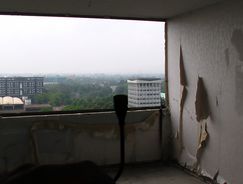The acoustical palimpsest
'Normally I feel that the locations and spaces I move in are distinct and well-defined. I know where my kitchen is, and I recognise my street and the house I live in. But what happens when the interplay of my ordering system no longer coincides with the events around me?'
(Roswitha von den Driesch & Jens-Uwe Dyffort)
We're accustomed to defining spaces optically and describing routes with visual landmarks. Nobody says, 'Go straight ahead until you hear the robin and turn left where the jackhammer drowns out the police siren'. In contrast Roswitha von den Driesch and Jens-Uwe Dyffort, two Berlin sound-artists who have been working together since 1996 and who won the German 'Klangkunst' Award in 2006, create acoustical spaces that counteract the alleged certainties of visual perception. They design artificial soundscapes and mark out acoustical surfaces and paths, thereby unearthing spaces buried by the course of history or awaiting discovery in the future. Their works resemble a palimpsest, disclosing things overwritten and concealed. Their installations, they insist, are not staged events, but an expansion of space that paves the way to new experiences.
The dotted present
One of their key strategies is 'dotting'. Subdued clicks channel the spectators' attention in a direction other than the ones marked out by well-trodden paths and concrete walkways. No matter whether we are dealing with a long abandoned overgrown avenue on the Donaueschingen palace grounds (Punktierte Allee, 2009), the walls of the former Hamburg Railway Station in Berlin (Punktierter Garten ? Punktiertes Fragment, 2008) or the cloisters of a converted monastery in Metz (Punktierter Garten ? Cloître des Rècollets, 2008), the sound-dots invariably point to hidden architectural layers. The pointedly simple clicks, produced by switching piezoelectric speakers on and off, are judiciously embedded in their environment. They blend with natural sounds, with insect noises and rustling leaves, but also with traffic noise, lending a second nature to the given situation.
The acoustical neighbour
These subtle installations are never obtrusive. Instead, they puzzle us with their ambivalence and their feeling for possibilities. This became especially apparent in two works that breathed fictitious life into empty rooms. Zeitweiliger Wohnsitz Grünstrasse 18 und 19 ('Temporary Residence Green Street 18 and 19', 2000) and Hofgeschenen (Hartmanns Sonntage) ('Courtyard Happenings [Hartmann's Sundays]', 2003-4) add the everyday sounds of imaginary residents to two empty buildings. Here someone fills a bathtub, there someone turns on the radio, a couple quarrel, a baby cries ? all co-ordinated with the 24 hours of an ordinary day. From the outside we can only guess what contributed to the reality of the backdrop and finally caused people to call the police, who pressed charges against the make-believe and allegedly illegal residents.
Awareness of possibilities in ?Klangkunst?
Driesch, who studied architecture as well as ?Klangkunst? and free art, and Dyffort, a trained composer and software engineer, are concerned with more than being provocative. Their works deal with things we overlook and overhear. The traces they unveil are not easily noticed by the observer and only become manifest through acoustical elaboration. Many of their creations take a conjectural 'what if?' as their point of departure. What if collapsing space could be visualised acoustically? To answer this question they buried 14 microphones in the rubble of a tenement house in Marl that was demolished in 2006 (Goliath, 2006). The implosion of the vanishing space, captured by these microphones just before their demise, lends an almost ghastly physiognomy to the latent acoustics of the architecture, suggesting that something living dies when concrete walls designed as residential space collapse. What if a conversation were reduced to parenthetical padding? What if all we hear are expletives such as 'er' and 'um'? Their installation ATS-1 (2008) filled the Golden Hall of Frankfurt Radio with all the expressions usually expunged in radio broadcasts to filter out the stammering and hesitations of human speech. What if all we heard on gramophone records were the beginnings and the endings, if we focused entirely on the crackling of the empty grooves? In their radio play 33.3 (2005) Driesch and Dyffort played the sounds that accidentally occur between the grooves, sounds that resist rational classification and prove that something acoustical happens even where seemingly nothing exists. These installations, no matter how unassuming their execution, open metaphysical gateways to a phantom world of sounds where a different reality awaits us.
Björn Gottstein
produced by
Deutscher Musikrat gemeinnützige Projekt-
gesellschaft mbH
Förderprojekte
Zeitgenössische Musik
Weberstraße 59, 53113 Bonn
P 02 28 - 20 91 170
F 02 28 - 20 91 200
E zm@musikrat.de
curators of the exhibition
Stefan Fricke,
Johannes S. Sistermanns


